Optimizing Airport Infrastructure for Future Growth: Integrated Planning and Data Analytics
In a world where the population continues to surge, so does the demand for air travel. To meet the future needs of passengers, airport infrastructure must prioritize the development of robust infrastructure. However, this process is time-intensive and can span several years before new infrastructure becomes operationally ready, thereby expanding airport capacity for landside operations. During this transitional phase, airport operators confront the challenge of relying on existing facilities while awaiting the full deployment of new ones, avoiding potential shortages. This delicate balancing act necessitates comprehensive planning and seamless collaboration among all team members.
Integrated Planning and Breaking Down Silos
One of the most potent tools for advancing airport infrastructure is an integrated planning approach that brings together various process units, stakeholders, and timeframes, ranging from long-term predictions to day-to-day operations. Initiatives such as the Airport Operations Plan (AOP), a creation of Eurocontrol and SESAR, show the immense optimization potential inherent in a collaborative approach. The AOP, born as a follow-up to the A-CDM initiative, aims to connect all facets of airport operations, facilitating planning, monitoring, and post-analysis of the whole process. This integrated planning approach enables the identification of potential bottlenecks that might arise due to interdependencies with other checkpoints along the passenger journey. This collaborative endeavor presents an organizational challenge, demanding cross-hierarchical cooperation toward a common vision.
In Data We Trust
As the adage goes, “You can have data without information, but you cannot have information without data” (Daniel Keys Moran). With technological advancements outpacing the capacity of airports to keep up, the volume of available data continues to expand. This underscores the imperative to set up analytical capabilities. Airports must assemble business intelligence (BI) teams and designate data officers to fully harness the available data, thereby ensuring that airports capitalize on business opportunities. Artificial Intelligence (AI) and Machine Learning represent two technologies capable of significantly supporting and streamlining individual work, ultimately reducing costs. Currently, human oversight is needed for setup and guiding processes to decode findings accurately. Anyways, these technologies are poised to reshape the future of work. From biometrics to object recognition and smart self-learning predictions, the potential use cases are vast and promise further optimization of airport infrastructure. The key advantage lies in the wealth of data generated by these systems, which can furnish essential information for creating a digital identity of the airport, often referred to as the “digital twin.” This digital replica of the airport environment, encompassing all resources and facilities in conjunction with key metrics, enables stakeholders to make real-time decisions and engage in immediate what-if scenarios, simplifying problem-solving.
Learning from Real-Life Success Stories
Examples of successful digital transformations within the aviation industry abound, underscoring the value of collaboration and enhanced data exchange in improving overall operational efficiency. Digitalization enhances transparency, communication, and airport management. For instance, Frankfurt Airport implemented an operational data warehouse, laying the foundation for analytics across various business units. This data unlocks fresh insights, facilitating the development of data-driven projects. Leveraging forecasting and simulation, Frankfurt Airport successfully linked flight-related activities to passenger processing, empowering planners and operations to optimize facility and resource usage.
Where Capacity Meets Technology
To satisfy the mounting demand, it’s imperative to merge technology and collaboration in optimizing airport infrastructure. Capital expenditures on IT solutions often prove to be more cost-effective than traditional concrete construction, yielding a higher value per square meter per passenger. Ensuring that airports are equipped with the right technological tools is essential for building smart, efficient, and passenger-friendly airports for the future.
